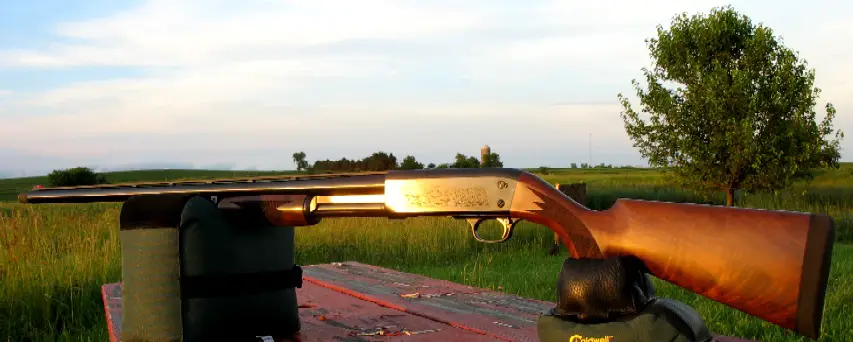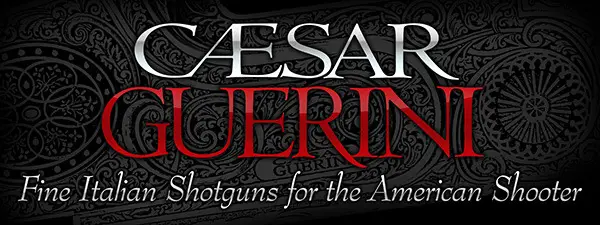


The Overlooked Pump-action Shotgun
Some may recoil at
the notion of the slide-action shotgun being “overlooked,” for
year after year it is the most popular shotgun action sold and used in
the United States: nothing else comes remotely close.
It is a vibrantly American shotgun that started its reign with the introduction
of the Winchester Model 97 designed by John Moses Browning. The Model
1897 was the oldest shotgun design to sell one million units, though it
took nearly its entire production run, from 1897 through 1957, to hit
that level. It wasn't the first trombone action shotgun, but the first
highly successful one.
The 1897 itself was
a stronger, more durable upgrade from the Browning-designed Winchester
Model 1893, the Model 93 itself based in part on the Spencer. As a footnote,
the first repeating shotgun considered successful was the Model 1887 lever-action
shotgun, again designed by John M. Browning. The Model 97 was my Dad's
first shotgun: that's what most of his paper-route money was invested
in.
It didn't hurt that the Model 97 was the fearsome “Trench Gun”
of WWI, and it didn't hurt that many (or most) American trap and skeet-shooters
used trombone actions from the 1920s through the 1950s. When I was a young
boy, if you had a Model 12 (or an Auto-Five), you were living pretty large
for most hunting and shotgunning needs.
Rudy Etchen felt that pumps were the most shotgun for the money, agreeing, “ I think so, at least among guns that shoot more than once. Although standard-grade pumps can cost twice as much as economy versions, they're still less expensive than most gas autos of the same grade.” That certainly hasn't changed much, for it appears to be the case with the Ithaca Model 37 Featherlight and the Remington 870 Wingmaster: both “standard grade” according to Rudy Etchen.
What has been downgraded is the general perception of standard grade and quality. It wasn't always so, for when Winchester attempted to replace the Model 12 with the comparatively poorly made Model 1200, there were cries of anguish. It didn't go over with the U.S. Military, either, as it was in service from 1968-1969.
Having entry-level shotguns isn't a new idea, for there has always been a wide assortment of “spec” guns, sold by Sears, Montgomery Wards, J. C. Penney, and Western Auto among other outlets. Go out for quotes and buy from the cheapest bidder, that particular year, was the norm. While some of the “J.C. Higgins” / Ted Williams genre product was good, the actual company of manufacturer varies, and naturally so did the quality.
I can't think of
many terms less romantic that “serviceable” and “functional.”
If you tell your best girl that she is “serviceable” or that
dinner she made for you was “functional,” I can't tell you what
your next meal might be, specifically, except that it will likely be similar
to an old thick dry slice of “cold shoulder.”
Several pumps of years gone by fit that category. Some years of the “High
Standard Flite King” were good for the entry-level category, and
the old Marlin Magnum 120 was a durable but lackluster attempt at recreating
the Model 12 feel. Both were generally serviceable and functional, though.
Over the years, the standards have been lowered as to what constitutes a “standard grade” pump. The top three remaining in production on the fundamental standards of good machining, good triggers, reasonable finish, reasonable aesthetic value, a slick, smooth action, and steel receivers number only two: the Ithaca Model 37, and the Remington 870 Wingmaster.
The irony of this is that the Ithaca started with the Remington Model 17 that was available only in twenty gauge, was adapted by C.C. Loomis into the side-ejection Remington Model 31 (the “ball-bearing pump”) that was itself discarded in favor of the less costly to produced 870. Yet today, today, they are the best trombone guns on the market.

Though not rising to the veteran standards of “standard grade” in a few ways, the Mossberg 500 and the Benelli Nova hit the serviceable and functional levels, and the heavy and heavy triggered Browning BPS is a durable pump-gun as well with a bit better level of finish than the first two. Still, they do not meet the standard of average quality of years ago. Despite the astounding success in numbers of pumps, with the Remington 870 dating back to 1951, it is hard to call it much more than close to sixty-five years unmarred by progress.
It isn't that pump shotguns are overlooked as much as the truly good quality examples are. With the majority of pump-shotguns being both of shoddy, bearly acceptable to poor quality and of Chinese or Turkish manufacture, I have to wonder how many folks have every owned a truly good trombone gun. They are really missing something.
Copyright 2014 by Randy Wakeman. All Rights Reserved.

Custom Search



